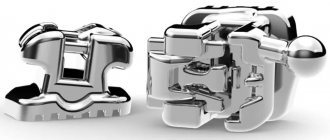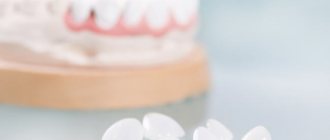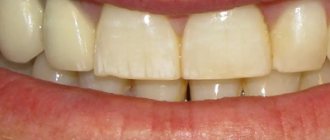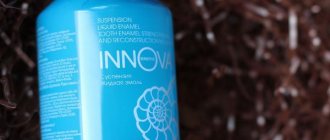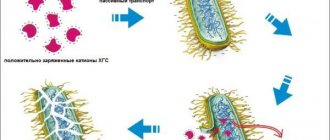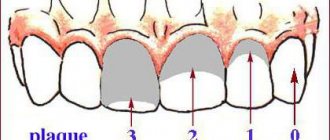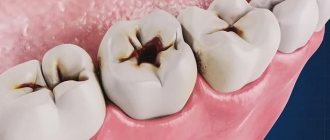How to identify milk caries?
It is quite simple to identify caries in young and older children. White or brown spots appear on the teeth, a painful reaction to hot and cold is observed, and the child may develop bad breath. When these first symptoms of caries appear, it is already worth sounding the alarm, since the carious process is developing very rapidly. It is characterized by almost instantaneous damage to several teeth, and if measures are not taken, the entire dentition may be affected. Of course, it is often difficult for a child to articulate that his baby tooth hurts. He may refuse to eat or chew on only one side. This should also alert parents and encourage them to take their child to pediatric dentistry.
Treatment strategy depends on the child's age
One-year-old children experience damage to their incisors. Experts do not use a drill and prefer gentle methods: remineralization or fluoridation. The protective coating increases resistance to pathogenic bacteria.
Safe technologies are also used for children under 3 years of age. For complete protection, silver nitrate is applied to the surface. If the pathology is already developing, then tissue cleaning and laser treatment are carried out. A universal method is to seal cracks and depressions in the front and chewing teeth.
After reaching 5 years of age, ozone therapy can be used at the initial stage and depophoresis at the severe stage. With depophoresis, a composition with copper and calcium is injected directly into the root canals, which cures the disease 100%.
At the age of 5 to 9 years, fillings can be used, but photopolymer and light materials cannot be used. Preference is given to colored compomers and glass ionomer fillings.
Once the child is 10-12 years old, adult technology can be used due to the large number of molars. But at the same time, methods with high trauma are avoided. Fissure sealing is still an excellent way to treat chewing teeth.
Treatment of superficial caries in children in the dental department of CELT is carried out in two ways:
- silvering - involves applying a silver solution to the tooth surface;
- fluoridation - involves applying special solutions with calcium, fluorine and phosphorus to the tooth surface, which allow you to restore the mineral balance of the teeth.
These methods provide the necessary protection for tooth enamel and maintain their integrity. In the most difficult cases, we treat caries in children under anesthesia (or general anesthesia). In this case, the safest drugs are used, which do not accumulate in the body and have no contraindications. In this case, your baby simply falls asleep for a while and wakes up with a happy smile!
What are the causes of caries in primary teeth?
There are more reasons for caries of baby teeth in children than meets the eye. This includes improper oral hygiene, sharing cutlery with adults who have caries, and much more. However, the main causes of occurrence are the influence of consumed carbohydrates that destroy the tooth, accidental infection from a carrier of a carious infection, a genetic factor, the immaturity of the children's skeletal system, and improper use of pacifiers and nipples.
- Of course, the main and most common cause of caries in primary teeth in children is poor oral hygiene and the influence of sweets. According to statistics, caries develops in young children in 73% of cases. Sucrose, glucose and fructose are the acids that are formed during the fermentation of carbohydrates and lead to the destruction of enamel. Immediately after ingestion of carbohydrates, the pH of saliva decreases from 6 to 4, and pathogenic bacteria settle in food debris that is not cleaned from the teeth.
- Remember the children's saying “from mouth to mouth you get a germ”? It turns out that she is not so far from the truth. The fact is that caries is an infection, an infection. That is, a loving parent, being a potential carrier of carious microbes, does not even suspect that by kissing his baby or sharing dinner with him, he can personally infect his child!
- Another reason why caries may occur on baby teeth is genetic. Teeth begin to form during the prenatal period, in the first trimester of pregnancy. Therefore, smoking by a negligent parent, her illnesses suffered during this period, or taking medications can lead to disruption of the proper development of the child’s teeth.
- Childhood caries of primary teeth may be associated with the following factor: children’s teeth have a low degree of mineralization and erupt “immature”, and only then “mature” in the oral cavity. Final mineralization lasts for one and a half to two years for baby teeth and about three years for permanent ones. Pediatric dentists call such periods of “maturation” the most susceptible to caries. Therefore, the reasons why caries occurs in primary teeth at an early age may also be chronic diseases, the effects of medications, the composition of saliva and the fluoride content in water and food.
- Another cause of caries of primary teeth in young children is improper use of pacifiers. A baby who falls asleep with a bottle in his mouth runs the risk of getting caries on his front teeth, so-called bottle caries. In this case, prolonged contact of the sweet liquid with the teeth leads to caries of all front teeth. In this case, the disease spreads around the entire visible part of the tooth along the perimeter.
As you can see, there are more than enough reasons for the appearance of childhood caries in baby teeth. But they all boil down, as a rule, to demineralization of teeth and destruction of hard tissues. Characteristic changes occurring in teeth can only be diagnosed by a dentist. Further treatment will depend on how severe the caries has developed. What are the stages of development of caries in primary teeth?
Stages of caries of primary teeth
Dentists distinguish the following stages of caries of primary teeth in children:
- Elementary;
- Surface;
- Average;
- Deep;
Initial caries of primary teeth
Initial caries of baby teeth can be recognized as follows: white spots of different shapes and sizes appear on the enamel, but there is no pain. In an “advanced” case, the initial caries progresses - the spots darken, becoming brown and then black.
Superficial caries of primary teeth
With superficial caries of primary teeth, the dental tissue defect is located within the enamel, and the carious cavity can be either light or dark. However, in this case, pain occurs when the tooth comes into contact with sweet, sour or salty foods. In this case, treatment of the baby tooth and filling of the cavity is already required.
Average caries of primary teeth
Average caries of primary teeth affects the enamel and internal dental tissue, dentin. In addition to the unpleasant sensations from sweet, sour and salty, pain from hot and cold is added. In this case, just as with superficial caries of primary teeth, filling is necessary.
Deep caries of baby teeth
With deep caries of primary teeth, the enamel and a significant part of the dentin are affected. If treatment is not carried out at this stage, then caries can affect the pulp of the tooth and then reach the root, often causing a cyst in baby teeth. Here you just need to see a doctor before the infection goes further. In this case, severe caries of primary teeth and its treatment will depend on how deep the caries has spread.
Is it possible to restore a dead nerve?
If the nerve does die, our dentists can help restore it. We have a unique revascularization technique that helps “bring back to life” pulp tissue. In this case, the doctor carries out the work, dividing it into several stages:
- The dental canals are sterilized and cleaned.
- Filling the channels with medicine and the patient's blood cells.
- Sealing the canal.
- Over the course of several months, a special tissue appears that replaces the functionality of the nerve and allows the tooth to develop and grow, and the roots and enamel to become stronger.
During the treatment process, doctors will monitor the process of pulp restoration using computed tomography.
Is caries treated in baby teeth?
Is it necessary to treat caries on baby teeth? This question still remains open for some parents. Even knowing that the child has caries, they are in no hurry to see a doctor, thinking as follows: “the milk teeth will fall out anyway.” Such judgments are absurd, because infected baby teeth will lead to complications in the growth of permanent teeth or provoke an exacerbation of other diseases in the baby’s body. One way or another, you will have to remove the baby tooth ahead of time. Caries in pediatric dentistry is considered one of the most common diseases, so both parents and specialists should ask the question “why is it necessary to treat caries of primary teeth?” Dentists believe that treatment of caries in a baby tooth will preserve it until the “arrival” of the molars.
Tooth preservation
In our clinic, doctors follow the most important principle when treating small patients: do everything possible to keep the pulp alive! Only thanks to it will the tooth be completely formed, its roots will become stronger, and the enamel will increase to the required thickness.
Therefore, pediatric dentists at the Dentville clinic use materials that are biologically compatible with the child’s body - constant monitoring of pulp regeneration processes allows it to be restored even in cases of deep nerve damage by caries.
Treatment of caries of primary teeth in children
If the doctor finds that a child has incipient caries, then most likely, treatment of baby teeth will not be required. The specialist will protect the enamel from further destruction using a painless and effective procedure - applying fluoride varnish or a silver fluoride compound. Then, when the baby gets permanent teeth, the dentist can seal the fissures - the depressions between the elevations of the tooth - which will prevent the occurrence of bacterial plaque that destroys the enamel. If caries progresses, you can no longer do without filling. The doctor will quickly and almost painlessly remove the affected tissue and hermetically seal the tooth. Otherwise, caries can develop into pulpitis in a child, and then into periodontitis.
Stages of treatment of caries of primary teeth
- Before administering anesthesia, the doctor must numb the injection site using special gels or spray. Moreover, the content of the anesthetic component should be minimal. Anesthesia is, as a rule, carried out only in cases where pulp removal is required - that is, with medium and deep caries of primary teeth.
- It is advisable to remove affected tissue using hand tools or a drill, taking frequent breaks.
- As fillings, materials that can be applied “one time” should be used in order to reduce the operation time.
- If a child has deep caries of primary teeth and its treatment requires the necessary filling of the roots, then the canals are disinfected without special mechanical treatment and filled with a special paste.
- Treatment of baby teeth in children should take no more than half an hour, otherwise the child will get tired.
- Treatment of severe caries of primary teeth, as a rule, takes place in several stages and requires the use of sedation.
- Dental treatment under general anesthesia in children is carried out strictly according to indications;
You can get rid of carious lesions at the initial stage using modern methods of caries treatment without a drill. Comfortable, painless treatment is suitable for those children who are afraid of manipulation with a dental bur. The cost of treating caries in baby teeth without a drill is slightly higher than the price of traditional dental treatment for children, but it is worth it. If simple caries gives complications, then you will have to resort to classic drilling. The cost of treatment of complicated caries of primary teeth will depend on the degree of neglect of the disease.
"Microscopic" treatment
Due to the fact that tooth enamel in adolescents and children is very thin, dental treatment can be difficult - there is a high risk of tooth destruction and damage to the enamel. To avoid risks, specialists at the Dentville clinic use a special dental microscope, which helps to enlarge teeth many times over and, with pinpoint precision, clean and sterilize dental canals and install miniature fillings that will last much longer than massive ones. Thanks to a microscope, the likelihood of keeping the tooth nerve alive and not damaging it is significantly increased.
Prevention of caries in children
Prevention of childhood caries includes several areas, which boil down to proper nutrition, as well as home and professional hygiene.
- Individual oral hygiene. Home hygiene means that as soon as the first tooth hatches, a brush for the baby should appear in a glass next to the parents’ brushes. The same applies to toothpaste. At first, the paste can be applied to gauze or a fingertip to clean your teeth so as not to injure your delicate gums. You need to clean your teeth from all surfaces vertically, then wipe them with a brush soaked in water. Thus, firstly, plaque will be removed, and, secondly, parents will teach the baby to take care of the oral cavity.
- Prevention of caries with the help of a well-chosen diet. As for nutrition, parental duty is to breastfeed the baby from the very beginning. There is no need to talk about the beneficial properties of breast milk, and the sucking process greatly affects the developing jaw system. Then the baby should be accustomed to fermented milk products. By six months, the child should be fed kefir, and later - cottage cheese and cheese. Parents should remember that the main formation and formation of permanent teeth occurs up to 3 years. This means that calcium must always be present in the daily diet.
- Professional oral hygiene. This type of prevention involves periodic visits to the dentist and hygienist. The first visit should occur on your first birthday. The specialist will not only give recommendations for care, but also create a diet regimen and examine the mouth. When the first teeth emerge, you and your child will be shown how to brush their teeth properly at an appointment with a hygienist. If there is a problem such as tartar in children, you cannot do without professional hygienic cleaning. It is important for parents to make it a rule to visit the doctor twice a year. And if there are problems with teeth, then more often - once every three months. This is largely due to the fact that various pathologies develop too quickly in childhood. Meanwhile, early diagnosis will lead to quick, painless and relatively inexpensive treatment of caries.
As you can see, in most cases, when caries can attack children's teeth, parents are able to rebuff it decisively. Of course, there is no escape from genetic predisposition. But it’s not without reason that dental experts say that sweets are the main cause of the development of the disease! So isn’t it better to eliminate the constant source of bacteria and, instead of harmful carbohydrates, offer the child fruits, which are much healthier, after the main meal? Ultimately, your child will thank you in the future for being vigilant and maintaining healthy teeth!
Prevention of dental caries
Methods for preventing dental caries in adolescents can be divided into 2 groups:
- Endogenous: prophylactic agents are taken orally.
- Exogenous: acting directly on dental tissue [1].
Endogenous methods of caries prevention include:
- a balanced diet containing foods rich in minerals, in particular calcium;
- drinking fluoridated water with an acceptable concentration of fluoride ion;
- inclusion of mineral fortifiers in the diet;
- taking calcium supplements (glycerophosphate, gluconate, calcium lactate, etc.);
- consumption of vitamin-mineral complexes containing calcium [3].
Exogenous methods of caries prevention include:
- applications and rinses with calcium-containing solutions;
- coating teeth with fluoride varnish in the dentist’s office;
- use of fluoride-containing oral hygiene products (toothpastes, rinses);
- the use of biosoluble remineralizing films and plates with calcium [1].
Caries on the front milk teeth - what to do?
On the front milk teeth, caries occurs almost as often as on the lateral ones. What should the child’s parents do in such cases? Be sure to take him to the dentist, regardless of the stage of the disease. Even if you notice a white spot on your baby’s front teeth, do not delay visiting the doctor to avoid further development of caries, its complications and other unpleasant consequences that pose a threat to the health of the child’s future permanent teeth.
Instead of empty spaces - tabs
The Dentville Clinic pays close attention to young patients! If our doctors are faced with the impossibility of saving a tooth, then we offer unique solutions that will help avoid bite problems that may arise due to voids:
- microprosthetics;
- lightweight crowns suitable for children's teeth;
- installation of lightweight tabs.
In the future, microprostheses, inlays and crowns can be replaced with ceramic structures, for example, crowns - and then the “adult” dentists of the Dentville clinic will be waiting for you!
Caries of primary teeth and its ENT complications
Sometimes parents unsuccessfully try to understand why their child often suffers from colds, complains of ear pain, and suffers from a chronic runny nose. And few people realize that the reason for weakened immunity lies in the baby’s untreated teeth. How can this be? It turns out that it’s all about pathogens! Caries develops under the influence of pathogenic bacteria, which can also cause diseases of the gastrointestinal tract and respiratory system of the child. Therefore, timely treatment of caries is important, including for maintaining the normal functioning of other organs of the baby.
Do baby teeth hurt due to caries?
Painful sensations when the surface of the teeth comes into contact with sweet, sour or salty food irritants is one of the first signs of incipient caries on baby teeth. Further, the discomfort in the affected teeth will only intensify, and when caries affects the pulp, the teeth begin to hurt like adults. In addition to acute pain, this stage of the disease is characterized by a high risk of premature removal of a baby tooth.
Publisher: Expert magazine about dentistry Startsmile.ru
Author of the material: Ekaterina Gasparova
